2017 MERCEDES-BENZ GLC belt
[x] Cancel search: beltPage 64 of 374
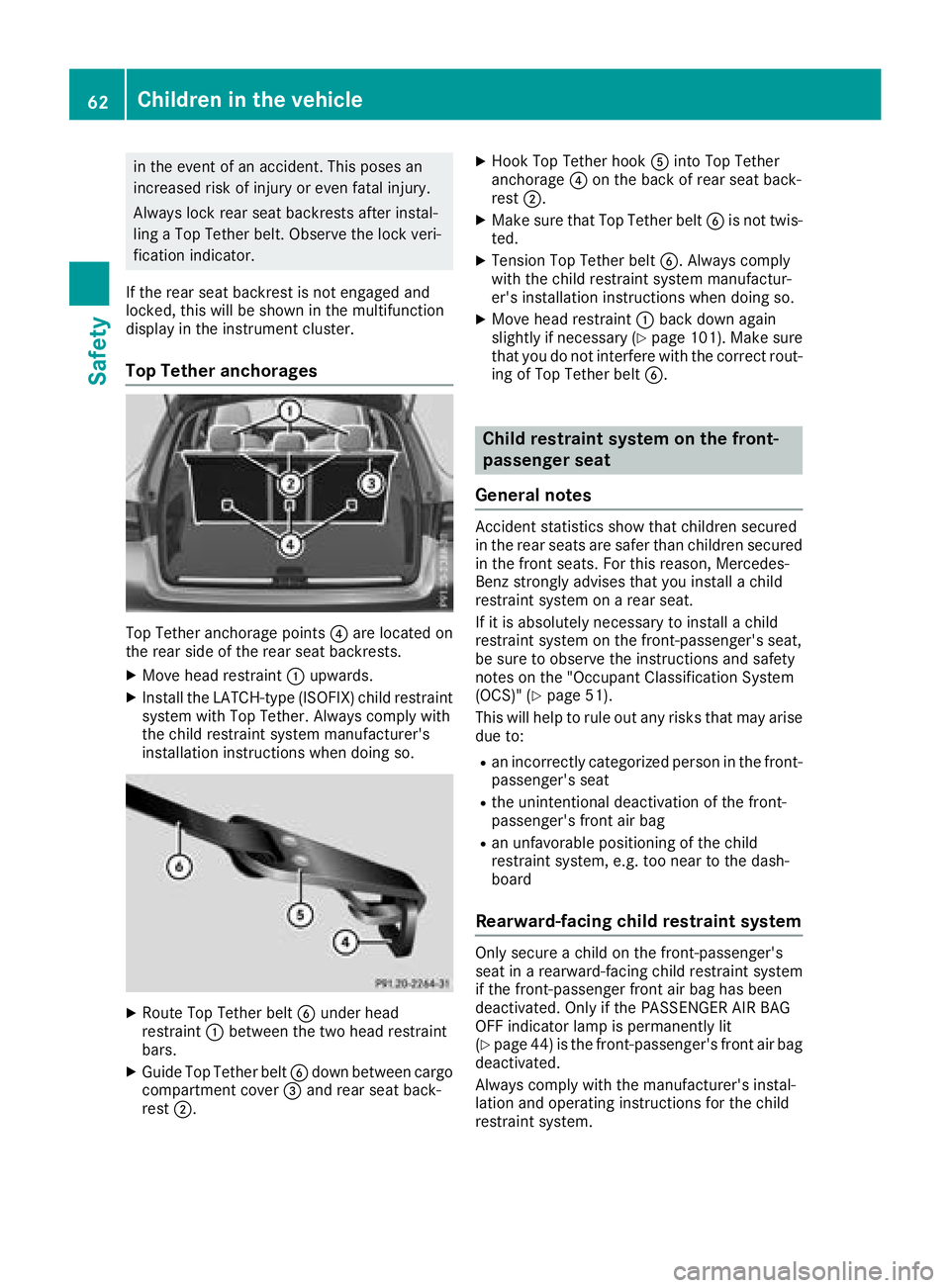
in the event of an accident. This poses an
increased risk of injury or even fatal injury.
Always lock rear seat backrests after instal-
ling a Top Tether belt. Observe the lock veri-
fication indicator.
If the rear seat backrest is not engaged and
locked, this will be shown in the multifunction
display in the instrument cluster.
Top Tether anchorages
Top Tether anchorage points �
Page 65 of 374
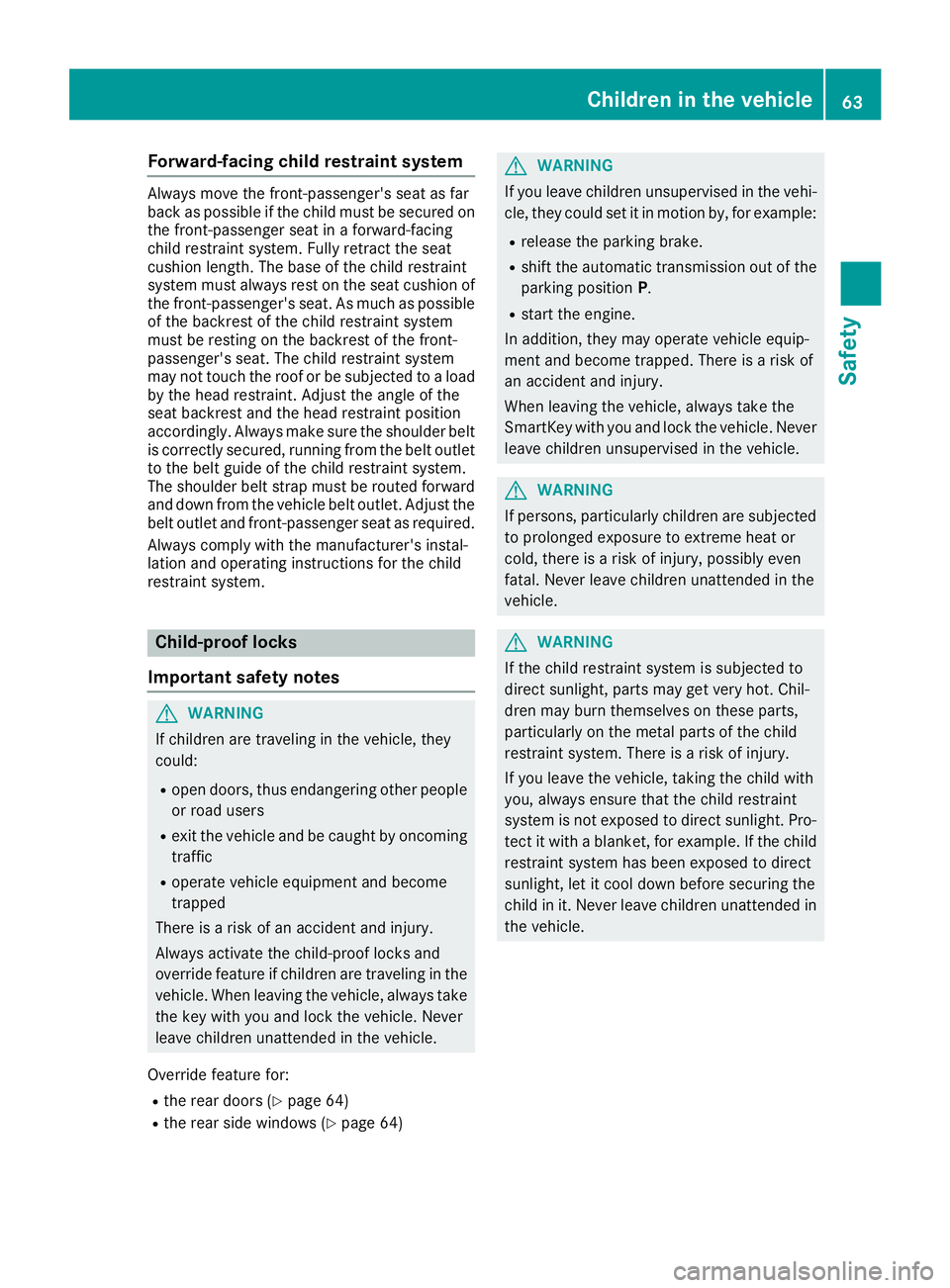
Forward-facing child restraint system Always mov e th e front-passenger's seat as far
bac k as possible if th e child must be secured on
th e front-passenger seat in a forward-facing
child restrain t system. Full y retrac t th e seat
cushion length. The base of th e child restrain t
system must always res t on th e seat cushion of
th e front-passenger's seat . As muc h as possible
of th e backrest of th e child restrain t system
must be resting on th e backrest of th e front-
passenger's seat . The child restrain t system
may no t touch th e roo f or be subjected to a load
by th e head restraint. Adjus t th e angle of th e
seat backrest and th e head restraint position
accordingly. Always mak e sure th e shoulder belt
is correctly secured , runnin g from th e belt outlet
to th e belt guide of th e child restrain t system.
The shoulder belt strap must be routed forward
and down from th e vehicl e belt outlet . Adjus t th e
belt outlet and front-passenger seat as required.
Always comply wit h th e manufacturer' s instal -
lation and operating instruction s for th e child
restrain t system.
Child-proof locks
Important safety notes
G WARNIN G
If children are traveling in th e vehicle, they
could: R
open doors, thus endangering other people
or road user sR
exit th e vehicl e and be caught by oncomin g
traffic R
operate vehicl e equipmen t and become
trapped
Ther e is a ris k of an acciden t and injury.
Always activat e th e child-proof locks and
override feature if children are traveling in th e
vehicle. When leaving th e vehicle, always tak e
th e ke y wit h you and loc k th e vehicle. Never
leav e children unattended in th e vehicle.
Override feature for :R
th e rear door s ( Y
page 64)R
th e rear side windows ( Y
page 64) G WARNIN G
If you leav e children unsupervised in th e vehi-
cle , they could set it in motion by, for example :R
release th e parking brake. R
shif t th e automatic transmission out of th e
parking position P . R
start th e engine.
In addition , they may operate vehicl e equip-
men t and become trapped . Ther e is a ris k of
an acciden t and injury.
When leaving th e vehicle, always tak e th e
SmartKey wit h you and loc k th e vehicle. Never
leav e children unsupervised in th e vehicle.
G WARNIN G
If persons, particularly children are subjected
to prolonged exposure to extreme heat or
cold, there is a ris k of injury, possibly eve n
fatal. Never leav e children unattended in th e
vehicle.
G WARNIN G
If th e child restraint system is subjected to
direct sunlight, part s may get ver y hot . Chil-
dre n may burn themselve s on these parts,
particularly on th e metal part s of th e child
restraint system. Ther e is a ris k of injury.
If you leav e th e vehicle, taking th e child wit h
you, always ensure that th e child restraint
system is no t expose d to direct sunlight. Pro -
tect it wit h a blanket, for example . If th e child
restraint system has been expose d to direct
sunlight, let it cool down before securin g th e
child in it . Never leav e children unattended in
th e vehicle.Children in the vehicle 63
Safety Z
Page 100 of 374
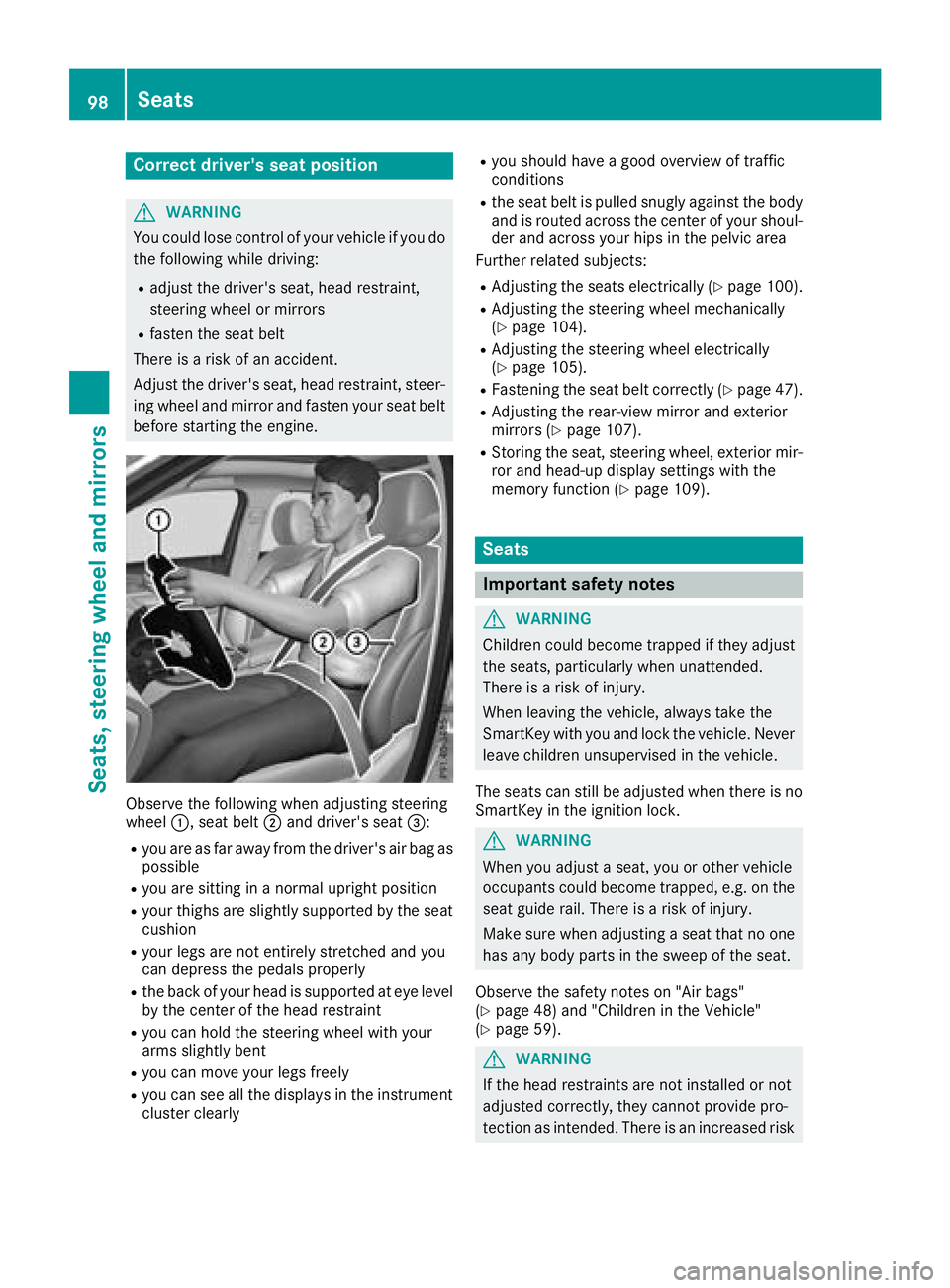
Correct driver's seat position
G WARNING
You could lose control of your vehicle if you do
the following while driving: R
adjust the driver's seat, head restraint,
steering wheel or mirrors R
fasten the seat belt
There is a risk of an accident.
Adjust the driver's seat, head restraint, steer-
ing wheel and mirror and fasten your seat belt
before starting the engine.
Observe the following when adjusting steering
wheel �C , seat belt �D and driver's seat �
Page 101 of 374
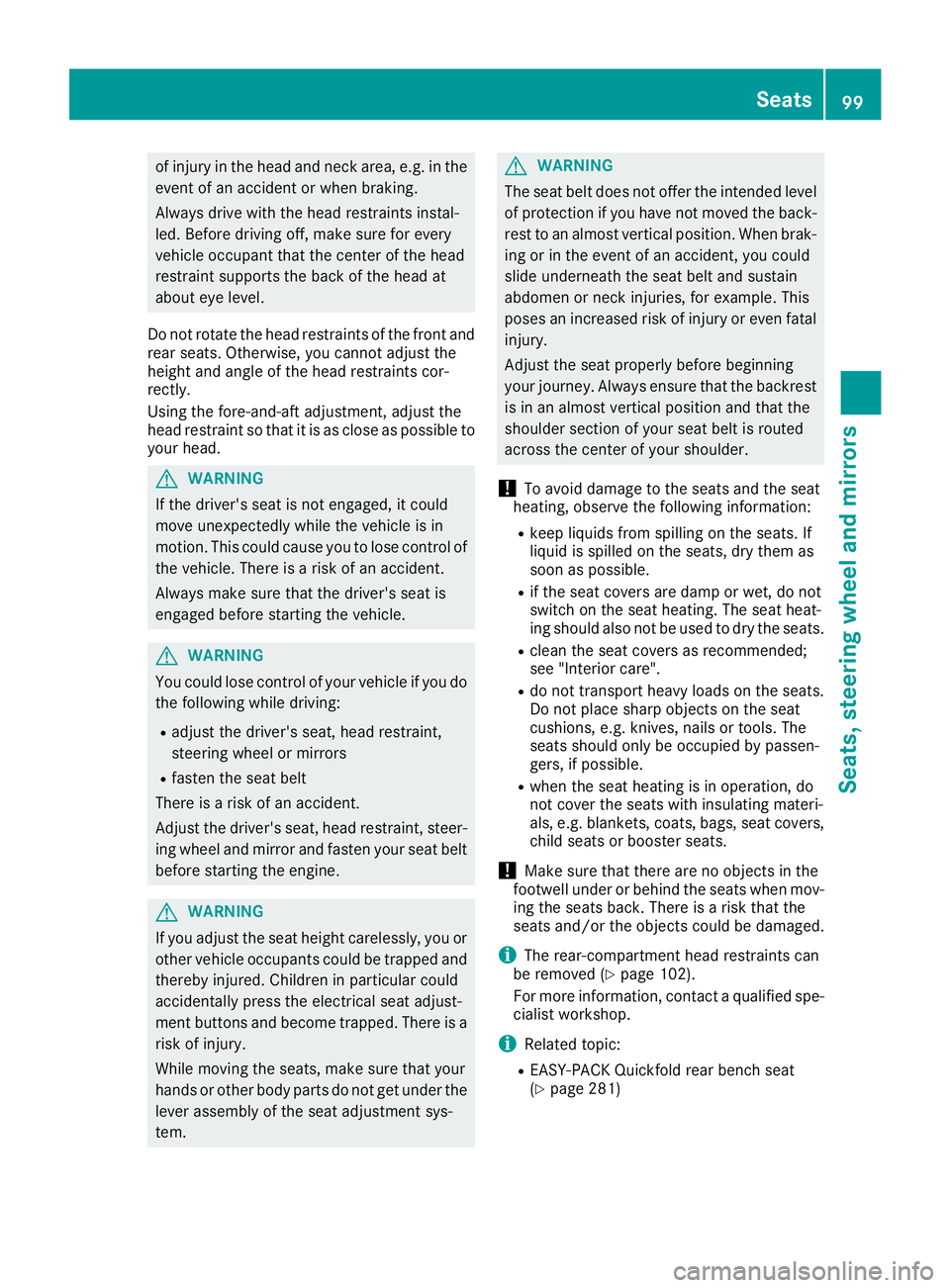
of injury in the head and neck area, e.g. in the
event of an accident or when braking.
Always drive with the head restraints instal-
led. Before driving off, make sure for every
vehicle occupant that the center of the head
restraint supports the back of the head at
about eye level.
Do not rotate the head restraints of the front and
rear seats. Otherwise, you cannot adjust the
height and angle of the head restraints cor-
rectly.
Using the fore-and-aft adjustment, adjust the
head restraint so that it is as close as possible to
your head.
G WARNING
If the driver's seat is not engaged, it could
move unexpectedly while the vehicle is in
motion. This could cause you to lose control of
the vehicle. There is a risk of an accident.
Always make sure that the driver's seat is
engaged before starting the vehicle.
G WARNING
You could lose control of your vehicle if you do
the following while driving: R
adjust the driver's seat, head restraint,
steering wheel or mirrors R
fasten the seat belt
There is a risk of an accident.
Adjust the driver's seat, head restraint, steer-
ing wheel and mirror and fasten your seat belt
before starting the engine.
G WARNING
If you adjust the seat height carelessly, you or
other vehicle occupants could be trapped and
thereby injured. Children in particular could
accidentally press the electrical seat adjust-
ment buttons and become trapped. There is a
risk of injury.
While moving the seats, make sure that your
hands or other body parts do not get under the
lever assembly of the seat adjustment sys-
tem. G WARNING
The seat belt does not offer the intended level
of protection if you have not moved the back-
rest to an almost vertical position. When brak-
ing or in the event of an accident, you could
slide underneath the seat belt and sustain
abdomen or neck injuries, for example. This
poses an increased risk of injury or even fatal
injury.
Adjust the seat properly before beginning
your journey. Always ensure that the backrest
is in an almost vertical position and that the
shoulder section of your seat belt is routed
across the center of your shoulder.
! To avoid damage to the seats and the seat
heating, observe the following information: R
keep liquids from spilling on the seats. If
liquid is spilled on the seats, dry them as
soon as possible. R
if the seat covers are damp or wet, do not
switch on the seat heating. The seat heat-
ing should also not be used to dry the seats. R
clean the seat covers as recommended;
see "Interior care". R
do not transport heavy loads on the seats.
Do not place sharp objects on the seat
cushions, e.g. knives, nails or tools. The
seats should only be occupied by passen-
gers, if possible. R
when the seat heating is in operation, do
not cover the seats with insulating materi-
als, e.g. blankets, coats, bags, seat covers,
child seats or booster seats.
! Make sure that there are no objects in the
footwell under or behind the seats when mov-
ing the seats back. There is a risk that the
seats and/or the objects could be damaged.
i The rear-compartment head restraints can
be removed ( Y
page 102).
For more information, contact a qualified spe-
cialist workshop.
i Related topic: R
EASY-PACK Quickfold rear bench seat
( Y
page 281) Seats 99
Seats, steering wheel and mirrors Z
Page 106 of 374
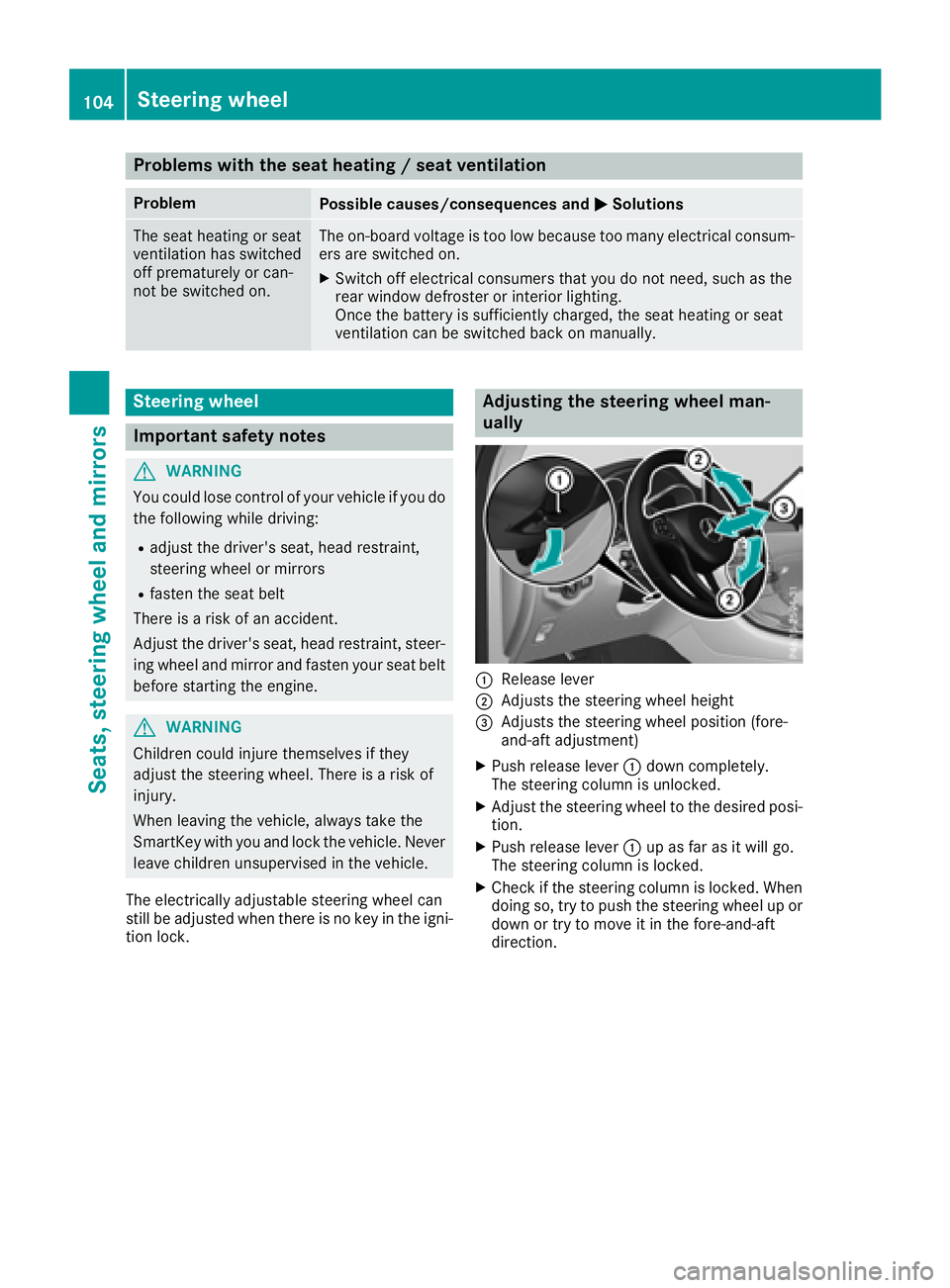
Problems with the seat heating / seat ventilation Problem
Possible causes/consequences and �P Solutions
The seat heating or seat
ventilation has switched
off prematurely or can-
not be switched on. The on-board voltage is too low because too many electrical consum-
ers are switched on. X
Switch off electrical consumers that you do not need, such as the
rear window defroster or interior lighting.
Once the battery is sufficiently charged, the seat heating or seat
ventilation can be switched back on manually.
Steering wheel
Important safety notes
G WARNING
You could lose control of your vehicle if you do
the following while driving: R
adjust the driver's seat, head restraint,
steering wheel or mirrors R
fasten the seat belt
There is a risk of an accident.
Adjust the driver's seat, head restraint, steer-
ing wheel and mirror and fasten your seat belt
before starting the engine.
G WARNING
Children could injure themselves if they
adjust the steering wheel. There is a risk of
injury.
When leaving the vehicle, always take the
SmartKey with you and lock the vehicle. Never
leave children unsupervised in the vehicle.
The electrically adjustable steering wheel can
still be adjusted when there is no key in the igni-
tion lock. Adjusting the steering wheel man-
ually
�C
Release lever �D
Adjusts the steering wheel height �
Page 108 of 374
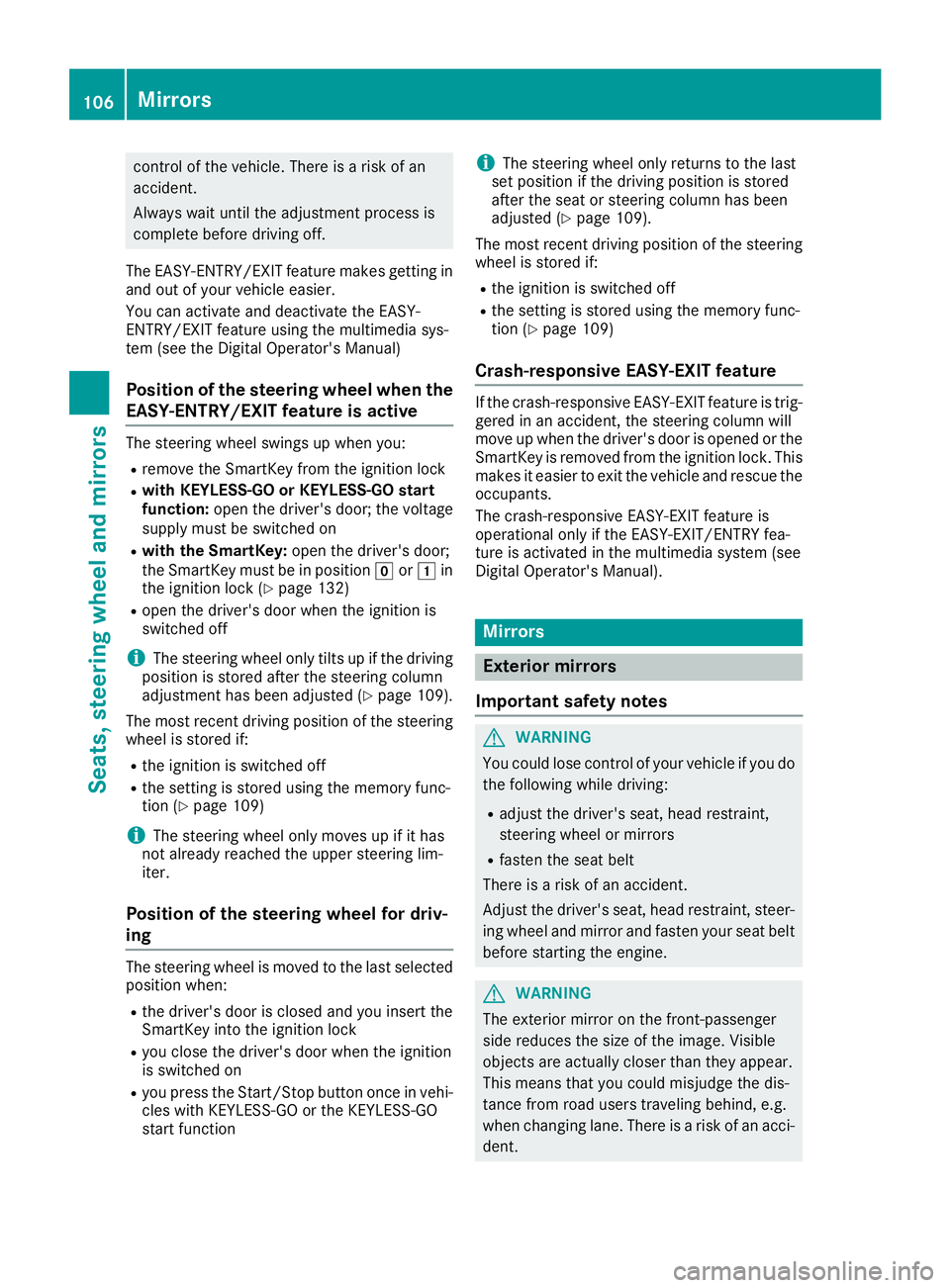
control of the vehicle. There is a risk of an
accident.
Always wait until the adjustment process is
complete before driving off.
The EASY-ENTRY/EXIT feature makes getting in
and out of your vehicle easier.
You can activate and deactivate the EASY-
ENTRY/EXIT feature using the multimedia sys-
tem (see the Digital Operator's Manual)
Position of the steering wheel when the
EASY-ENTRY/EXIT feature is active The steering wheel swings up when you: R
remove the SmartKey from the ignition lock R
with KEYLESS-GO or KEYLESS-GO start
function: open the driver's door; the voltage
supply must be switched on R
with the SmartKey: open the driver's door;
the SmartKey must be in position �Z or �G in
the ignition lock ( Y
page 132)R
open the driver's door when the ignition is
switched off
i The steering wheel only tilts up if the driving
position is stored after the steering column
adjustment has been adjusted ( Y
page 109).
The most recent driving position of the steering
wheel is stored if: R
the ignition is switched off R
the setting is stored using the memory func-
tion ( Y
page 109)
i The steering wheel only moves up if it has
not already reached the upper steering lim-
iter.
Position of the steering wheel for driv-
ing The steering wheel is moved to the last selected
position when: R
the driver's door is closed and you insert the
SmartKey into the ignition lock R
you close the driver's door when the ignition
is switched on R
you press the Start/Stop button once in vehi-
cles with KEYLESS-GO or the KEYLESS-GO
start function i The steering wheel only returns to the last
set position if the driving position is stored
after the seat or steering column has been
adjusted ( Y
page 109).
The most recent driving position of the steering
wheel is stored if: R
the ignition is switched off R
the setting is stored using the memory func-
tion ( Y
page 109)
Crash-responsive EASY-EXIT feature If the crash-responsive EASY-EXIT feature is trig-
gered in an accident, the steering column will
move up when the driver's door is opened or the
SmartKey is removed from the ignition lock. This
makes it easier to exit the vehicle and rescue the
occupants.
The crash-responsive EASY-EXIT feature is
operational only if the EASY-EXIT/ENTRY fea-
ture is activated in the multimedia system (see
Digital Operator's Manual).
Mirrors
Exterior mirrors
Important safety notes
G WARNING
You could lose control of your vehicle if you do
the following while driving: R
adjust the driver's seat, head restraint,
steering wheel or mirrors R
fasten the seat belt
There is a risk of an accident.
Adjust the driver's seat, head restraint, steer-
ing wheel and mirror and fasten your seat belt
before starting the engine.
G WARNING
The exterior mirror on the front-passenger
side reduces the size of the image. Visible
objects are actually closer than they appear.
This means that you could misjudge the dis-
tance from road users traveling behind, e.g.
when changing lane. There is a risk of an acci-
dent.106
Mirrors
Seats, steering wheel and mirrors
Page 139 of 374
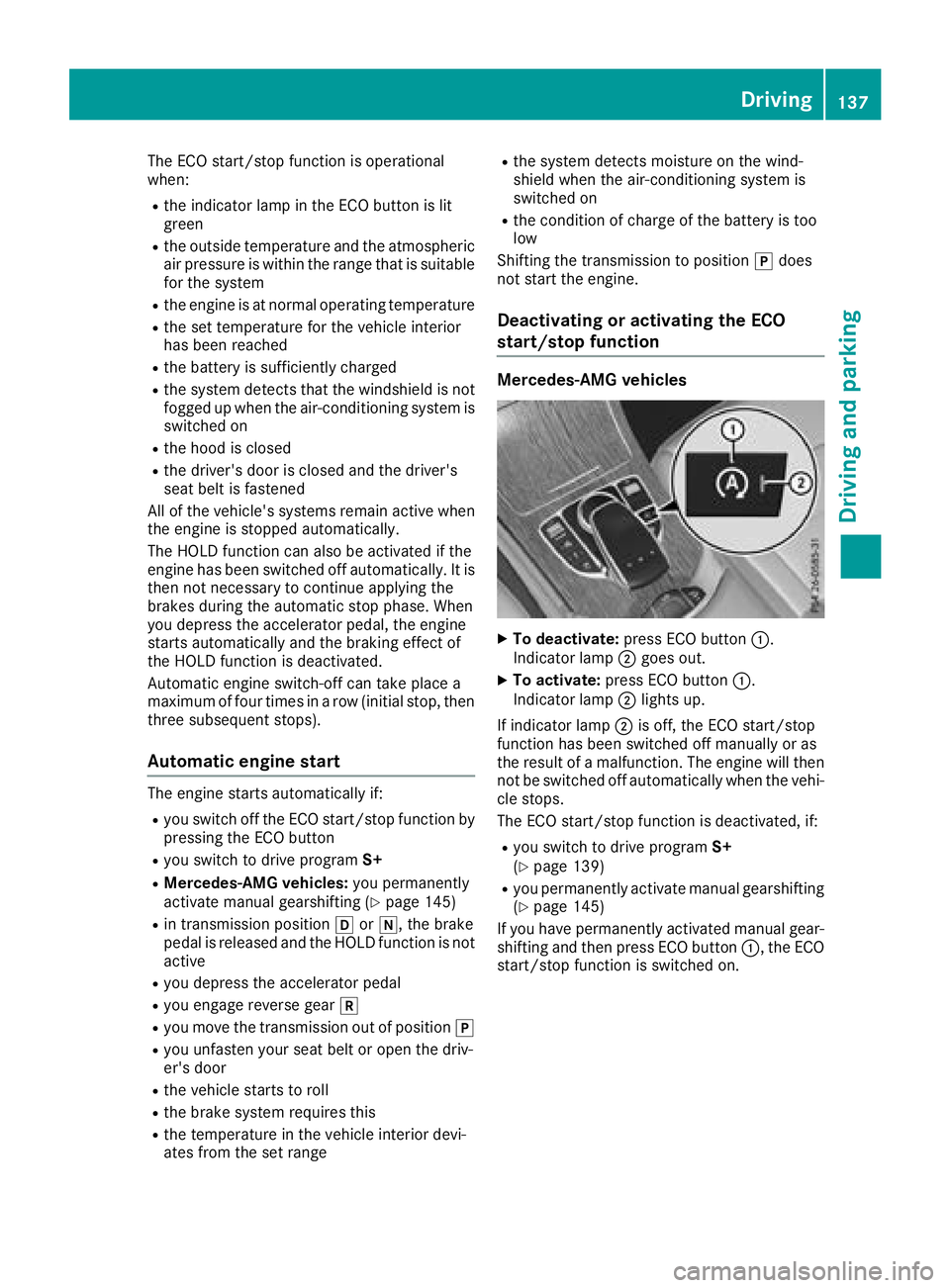
The ECO start/stop function is operational
when: R
the indicator lamp in the ECO button is lit
green R
the outside temperature and the atmospheric
air pressure is within the range that is suitable
for the system R
the engine is at normal operating temperature R
the set temperature for the vehicle interior
has been reached R
the battery is sufficiently charged R
the system detects that the windshield is not
fogged up when the air-conditioning system is
switched on R
the hood is closed R
the driver's door is closed and the driver's
seat belt is fastened
All of the vehicle's systems remain active when
the engine is stopped automatically.
The HOLD function can also be activated if the
engine has been switched off automatically. It is
then not necessary to continue applying the
brakes during the automatic stop phase. When
you depress the accelerator pedal, the engine
starts automatically and the braking effect of
the HOLD function is deactivated.
Automatic engine switch-off can take place a
maximum of four times in a row (initial stop, then
three subsequent stops).
Automatic engine start The engine starts automatically if: R
you switch off the ECO start/stop function by
pressing the ECO button R
you switch to drive program S+R
Mercedes-AMG vehicles: you permanently
activate manual gearshifting ( Y
page 145)R
in transmission position �[ or �\\ , the brake
pedal is released and the HOLD function is not
active R
you depress the accelerator pedal R
you engage reverse gear �^R
you move the transmission out of position �]R
you unfasten your seat belt or open the driv-
er's door R
the vehicle starts to roll R
the brake system requires this R
the temperature in the vehicle interior devi-
ates from the set range R
the system detects moisture on the wind-
shield when the air-conditioning system is
switched on R
the condition of charge of the battery is too
low
Shifting the transmission to position �] does
not start the engine.
Deactivating or activating the ECO
start/stop function Mercedes-AMG vehicles
X
To deactivate: press ECO button �C .
Indicator lamp �D goes out.X
To activate: press ECO button �C .
Indicator lamp �D lights up.
If indicator lamp �D is off, the ECO start/stop
function has been switched off manually or as
the result of a malfunction. The engine will then
not be switched off automatically when the vehi-
cle stops.
The ECO start/stop function is deactivated, if: R
you switch to drive program S+
( Y
page 139) R
you permanently activate manual gearshifting
( Y
page 145)
If you have permanently activated manual gear-
shifting and then press ECO button �C , the ECO
start/stop function is switched on. Driving 137
Driving and parking Z
Page 158 of 374
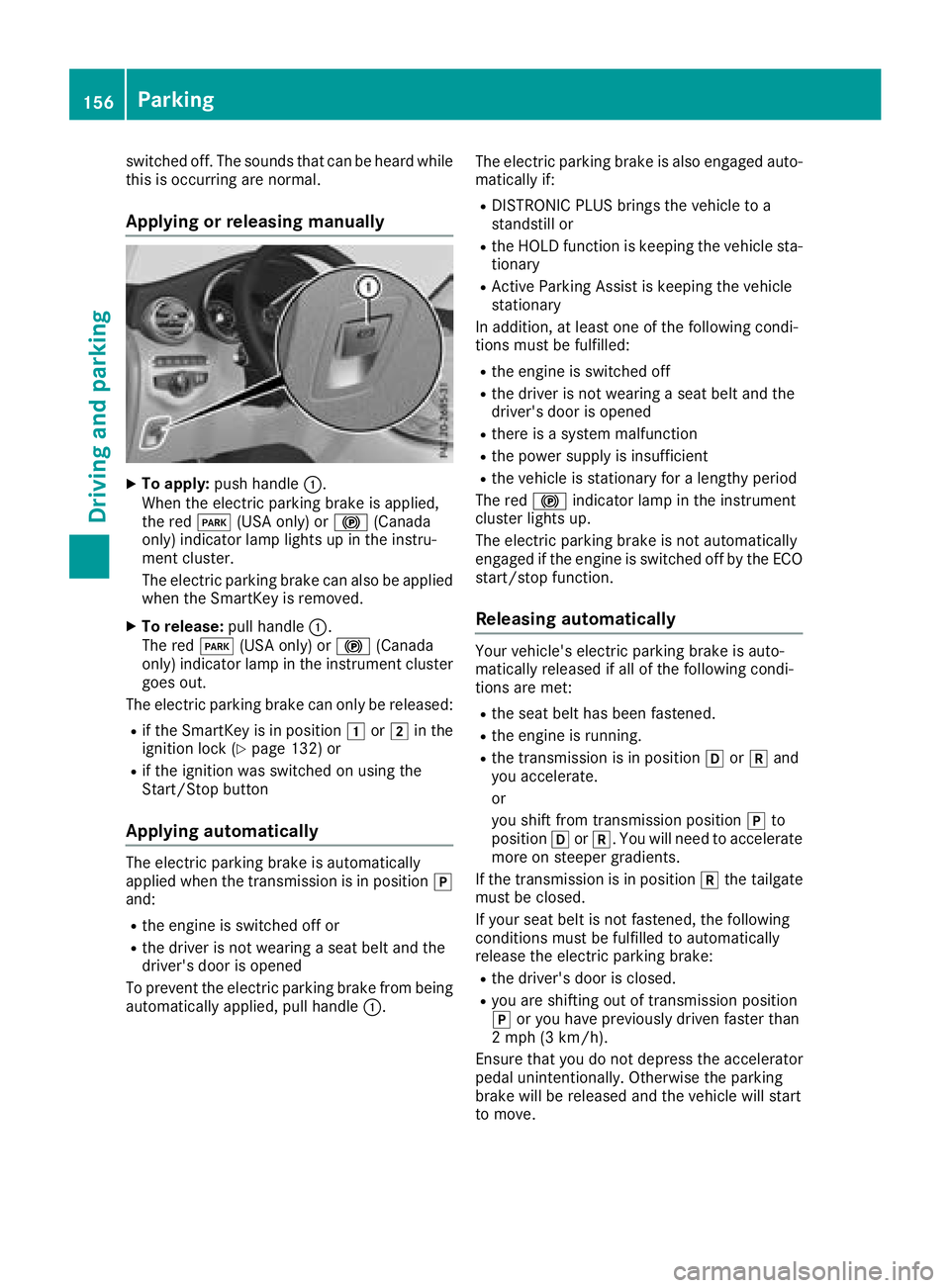
switched off. The sounds that can be heard while
this is occurring are normal.
Applying or releasing manually X
To apply: push handle �C .
When the electric parking brake is applied,
the red �I (USA only) or �$ (Canada
only) indicator lamp lights up in the instru-
ment cluster.
The electric parking brake can also be applied
when the SmartKey is removed. X
To release: pull handle �C .
The red �I (USA only) or �$ (Canada
only) indicator lamp in the instrument cluster
goes out.
The electric parking brake can only be released: R
if the SmartKey is in position �G or �H in the
ignition lock ( Y
page 132) orR
if the ignition was switched on using the
Start/Stop button
Applying automatically The electric parking brake is automatically
applied when the transmission is in position �]
and: R
the engine is switched off or R
the driver is not wearing a seat belt and the
driver's door is opened
To prevent the electric parking brake from being
automatically applied, pull handle �C . The electric parking brake is also engaged auto-
matically if: R
DISTRONIC PLUS brings the vehicle to a
standstill or R
the HOLD function is keeping the vehicle sta-
tionary R
Active Parking Assist is keeping the vehicle
stationary
In addition, at least one of the following condi-
tions must be fulfilled: R
the engine is switched off R
the driver is not wearing a seat belt and the
driver's door is opened R
there is a system malfunction R
the power supply is insufficient R
the vehicle is stationary for a lengthy period
The red �$ indicator lamp in the instrument
cluster lights up.
The electric parking brake is not automatically
engaged if the engine is switched off by the ECO
start/stop function.
Releasing automatically Your vehicle's electric parking brake is auto-
matically released if all of the following condi-
tions are met: R
the seat belt has been fastened. R
the engine is running. R
the transmission is in position �[ or �^ and
you accelerate.
or
you shift from transmission position �] to
position �[ or �^ . You will need to accelerate
more on steeper gradients.
If the transmission is in position �^ the tailgate
must be closed.
If your seat belt is not fastened, the following
conditions must be fulfilled to automatically
release the electric parking brake: R
the driver's door is closed. R
you are shifting out of transmission position
�] or you have previously driven faster than
2 mph (3 km/h).
Ensure that you do not depress the accelerator
pedal unintentionally. Otherwise the parking
brake will be released and the vehicle will start
to move.156
Parking
Driving and parking